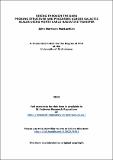Files in this item
Seeing through the dark : probing structure and processes across galactic scales using Monte Carlo radiative transfer
Item metadata
| dc.contributor.advisor | Wood, Kenny | |
| dc.contributor.author | MacLachlan, John Morrison | |
| dc.coverage.spatial | xxi, 155, [13] p. | en_US |
| dc.date.accessioned | 2016-09-12T13:23:01Z | |
| dc.date.available | 2016-09-12T13:23:01Z | |
| dc.date.issued | 2015 | |
| dc.identifier.uri | https://hdl.handle.net/10023/9481 | |
| dc.description.abstract | Radiative transfer methods provide a path to uncover the intrinsic properties of astronomical objects from observations. The determination of the shape, size and brightness of many objects is complicated by the interaction of photons with the material in the intervening medium. In this thesis I have explored the use of 3D Monte Carlo radiative transfer codes to investigate a variety of astronomical objects. A model has been created to calculate the transfer function for a simple model of the X-ray irradiated accretion disk around a massive black hole. I have reconciled the observationally derived accretion disk transfer function with a simple geometric model for the structure of the accretion disk in the active galactic nuclei Zw229-15. The results suggest that a change in the amount of flaring in the disk at ≈ 600AU, possibly due to the emergence of a disk wind, can explain the observations. By coupling a Monte Carlo photoionization code to a series of static snapshots of a numerical simulation of a star forming cloud I have been able to estimate the impact of photoionizing feedback on the stellar masses. It is estimated that the stellar mass formed over the course of the simulation is reduced by up to 38% by the action of photoionization feedback. I also illustrate the possible problems associated with stochastic sampling of the stellar initial mass function in clusters, on the number of ionizing photons produced. I have utilized multi-wavelength data for three low surface brightness disk galaxies to show that their dusty interstellar medium has a scale height equal to that of the stellar disk. This is in contrast to the structure seen in higher mass disk galaxies and may play a role in their low star formation rates. | en_US |
| dc.language.iso | en | en_US |
| dc.publisher | University of St Andrews | |
| dc.subject.lcc | QB468.M6 | |
| dc.subject.lcsh | Radiative transfer | en_US |
| dc.subject.lcsh | Monte Carlo method | en_US |
| dc.subject.lcsh | Astronomy--Statistical methods | en_US |
| dc.title | Seeing through the dark : probing structure and processes across galactic scales using Monte Carlo radiative transfer | en_US |
| dc.type | Thesis | en_US |
| dc.type.qualificationlevel | Doctoral | en_US |
| dc.type.qualificationname | PhD Doctor of Philosophy | en_US |
| dc.publisher.institution | The University of St Andrews | en_US |
This item appears in the following Collection(s)
Items in the St Andrews Research Repository are protected by copyright, with all rights reserved, unless otherwise indicated.

